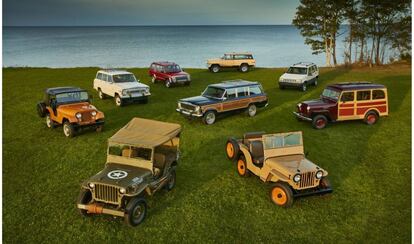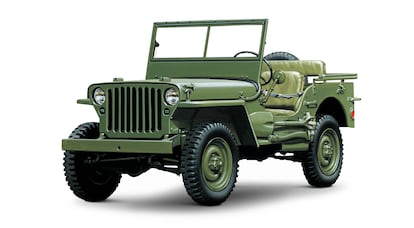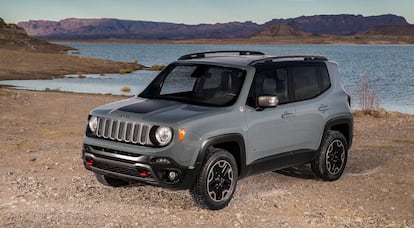What’s in a name? The story behind Jeep
The American automobile brand made its debut on the battlefields during World War II after winning a fiercely competitive government contract

In the early summer of 1940, the Ford Model Ts – which had been modified for military use as light transport and reconnaissance vehicles – were aging quickly. To relieve them from service, the General Staff of the United States Army summoned all manufacturers in the country and urged them to develop a new vehicle for the armed forces.
At least 135 manufacturers responded to the call and entered a fierce battle to win the government contract. The demands on them weren’t simple: the army needed a light reconnaissance vehicle that had to measure less than 6.3 feet and weigh less than 1,300 pounds. Such a vehicle would require excellent maneuverability and 4x4 transmission to be able to operate on any kind of terrain. On top of all of this, it had to be easy to disassemble and repair, given the turbulent nature of war.
With such a complex checklist, of all the bids submitted, only three automobile manufacturers made it to the final stage of the ruthless selection process: the Ford Motor Company, Willys-Overland Motors and the American Bantam Car Company. The competition was initially won by Bantam, but after several flaws were found in the company’s test models and production capacity, the contract was ultimately awarded to the Ohio-based Willys-Overland.

This company, founded in 1908 by the American automobile pioneer John Willys, finished developing and perfecting the prototype requested by the army and quickly began mass production. Output increased at an exponential rate after the Japanese bombed Pearl Harbor in 1941, which saw the United States enter World War II. Willy-Overland’s new military vehicle made its debut in a big way, as it was utilized in several decisive military actions in Europe, Africa and Asia as the Allies fought to push back against the Axis Powers.

Although the model was initially called MA and later MB, it soon became known as “Jeep.” The specific origin of this name is uncertain, although the most accepted version is that Jeep comes from the shortening of the words “general purpose” – military language used to refer to multipurpose reconnaissance vehicles. Another theory says that it was named after Eugene the Jeep, a character in the Popeye the Sailor cartoons, which were very popular at the time.
It did not take long for Jeeps to become highly appreciated and famous, among both Allied troops and civilians, who saw them in action on the news and in press photos. For instance, during Operation Overlord in 1944, when Allied forces stormed the coast of Normandy in northwestern France, Jeeps were prevalent in many of the images.

At the end of the war, in 1945, more than 368,000 Jeeps had been produced. In 1950, Wyllis-Overland decided to patent the informal name. Taking advantage of the success and popularity that it had achieved as a military vehicle, the manufacturer decided to transform it into a civilian one. The result was an off-road car that was baptized as CJ-2A – “CJ” stood for “civilian Jeep.”
In 1953, Willys-Overland merged with Kaiser Motors, a Michigan-based car maker. The new company was called Kaiser Jeep. Eight years later, the Wagoneer appeared, a larger version of the Jeep, built for families. It had an automatic gearbox to make driving on city roads more smooth.

The model – the predecessor to modern-day SUVs – immediately achieved high sales in the United States, thanks to its combination of ruggedness with the comfort of a high-end sedan. By 1984, it released the Grand Wagoneer, a larger and even better-equipped model. However, the brand did not completely depart from its military origins.
In 1986, the famous Jeep Wrangler was launched – a direct progression of the compact World War II model, but more sleek, meant for daily use in both urban and rural areas. It is currently in its fourth generation.
Jeep has always followed the same philosophy: to offer highly efficient off-road SUVs, but to also make them comfortable. Subsequent models have continued to strengthen the sales and prestige of the brand. When the Cherokee arrived in the mid-1970s – designed with a modern and larger body – it was quickly improved upon. The Grand Cherokee came out in 1993, offering a higher-end option to drivers.

In the present century, the Jeep range includes various models: from the Compass to the Patriot, from the Renegade to the Gladiator. There are pickups suitable for those working in the construction trades and luxury categories for business travellers.

Throughout its history, the Jeep brand has changed hands numerous times. In 1970, the company was acquired by the American Motors Corporation (AMC); five years later, it came under the management of Renault. After the French manufacturer failed to lift declining sales, Chrysler became the new owner in 1985.
More recently, in 2014, with the creation of the new Italian-American manufacturing group FCA (Fiat Chrysler Automobiles), all brands owned by Fiat and Chrystler were brought together, including Jeep. In 2021, FCA would merge with the PSA group (owner of the Peugeot and Citroën brands) and rename itself Stellantis. This gave rise to the world’s fourth-largest automobile producer, only behind Volkswagen, Toyota and Mercedes-Benz.
Under the management of Stellantis, the Jeep brand is now in the process of electrification. Jeep’s first 100% electric SUV, the Avenger, will be released at the end of 2022.
Tu suscripción se está usando en otro dispositivo
¿Quieres añadir otro usuario a tu suscripción?
Si continúas leyendo en este dispositivo, no se podrá leer en el otro.
FlechaTu suscripción se está usando en otro dispositivo y solo puedes acceder a EL PAÍS desde un dispositivo a la vez.
Si quieres compartir tu cuenta, cambia tu suscripción a la modalidad Premium, así podrás añadir otro usuario. Cada uno accederá con su propia cuenta de email, lo que os permitirá personalizar vuestra experiencia en EL PAÍS.
¿Tienes una suscripción de empresa? Accede aquí para contratar más cuentas.
En el caso de no saber quién está usando tu cuenta, te recomendamos cambiar tu contraseña aquí.
Si decides continuar compartiendo tu cuenta, este mensaje se mostrará en tu dispositivo y en el de la otra persona que está usando tu cuenta de forma indefinida, afectando a tu experiencia de lectura. Puedes consultar aquí los términos y condiciones de la suscripción digital.
More information
Archived In
Últimas noticias
Most viewed
- David King, chemist: ‘There are scientists studying how to cool the planet; nobody should stop these experiments from happening’
- Reinhard Genzel, Nobel laureate in physics: ‘One-minute videos will never give you the truth’
- Oona Chaplin: ‘I told James Cameron that I was living in a treehouse and starting a permaculture project with a friend’
- Mexico completes its trade shift with the entry into force of tariffs on China and countries without trade agreements
- Sinaloa Cartel war is taking its toll on Los Chapitos










































